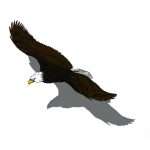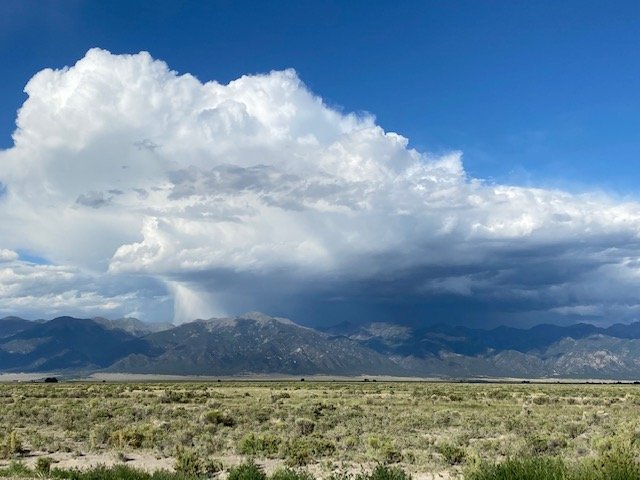by Hannah Fake
photo by Marlys Hersey
There is not a cloud in the sky, the sun has just made it over the horizon, and the air is still cool. The perfect weather for a day in the mountains. The birds are sing- ing in the forest and the trails are still quiet. Dappled shade from the vibrant aspens allows a little warming sun into the cool forest. Starting up the trail it feels like you could hike all day.
Moving along the trail that follows the creek to your right, you slowly gain elevation. Passing through the spruce and fir that blanket the ground with their nee- dles you can smell the piney scent that rises from the warming ground. Something moves ahead of you; you watch a deer bound off over fallen logs deeper into the forest.
A few miles further up the trail the forest is young, and you wish you were younger as you crawl over and under downed trees. It is a forest of ghosts; tall, dead Engel- mann spruce still stand where they once grew. The spruce bark beetle came through years before with populations so high the spruce couldn’t protect themselves. Now the younger trees are growing up; they were too small to make homes for the beetles when they reigned in the forest.
The trees become smaller and sparser. Meadows intersperse patches of spruce and fir. Recent rains have kept the grasses lush and green. It’s hot now; no trees for shade. You take breaks to enjoy the view, catch your breath, and feel the breeze. A small herd of cows graze on a mountainside off to the east. Columbine and paintbrush bloom in the meadows. Still slow- ly climbing, rocky areas begin to break up the meadows.
Walking along the ridge, there are views in every direction for miles. Clouds are building and shading the sun, and the breeze is picking up. It’s comfortable hiking again. Patches of phlox and penste- mon are growing among the rocks. A quick break and you are ready to get moving again as you get a little chilled. Maybe it’s the elevation or the cloud cover that’s lowering the temperature.
The darkened clouds stretch for miles but there are still patches of blue sky between. A distant rumble, maybe it’s a truck and trailer somewhere in the forest below. The peak is not far in the distance, the grade is lessening and there is an- other rumble of thunder. Suddenly it looks much darker and a curtain of rain is approaching. The first few drops start to fall. Time to turn around, now!
As the air rises over our mountains, it cools, creating tall, billowy clouds. The clouds become turbulent with warm moist air rising, then condensing as hail or rain.
Thunder rumbles almost directly overhead. Hiking down is easier; moving quickly and trying not to slip on the wet grass and rocks. A flash of lighting, one, two, three . . . you count as you pick up the pace. Thunder crashes again. The rain is cold, almost icy, as big drops fall. Heading to the tree line, to relative safety, is your goal.
A damp log in the forest is a good spot to rest now. The gray curtain of rain falls all around and thunder rumbles overhead. It’s summer in the mountains: mon- soon season. The building clouds bring the rain that keeps the mountainsides green, lets the flow- ers bloom, and the creeks run.
Hot and sunny days in spring and summer heat up the land in the Southwest. This causes a shift in wind patterns. The prevailing winds begin to blow from the cooler, moist ocean to the low-pressure areas of the hot and dry Southwest bringing moisture laden air up from the Gulf of California and Pacific Ocean. As the air rises over our mountains, it cools, creating tall, billowy clouds. The clouds become turbulent with warm moist air rising, then condensing as hail or rain. The moisture high in the clouds cools dramatically and drops in a downdraft. This turbulence creates the charges that bring lighting followed by the cracks and rumbles of thunder.
These storms often seem to appear out of no where or just materialize above. This happens because the air begins to rapidly rise, creating clouds, then rain and storms. It may rise quickly by being forced over a mountain or ridge, or because the air warms near the ground as the sun bakes the land.
Patches of blue sky still show in the distance and the rain begins to subside. It’s time to head for home, this storm has passed but another one is building not far away. The dead spruce are redder with their wash of rain; droplets, like jewels rest on leaves, and the puddles along the trail are rapidly soaking into the earth. Next time you’ll make it to the top, but it will require getting out of bed much earlier!
Hannah Fake is the San Juan Mountains Association visitor information coordinator for the Rio Grande National Forest. She enjoys spending time on the surrounding public lands but likes to be out of the mountains before the afternoon monsoons come through!


